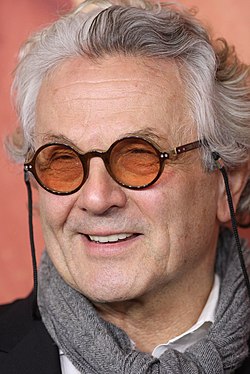Template:Short description Template:Use American English Template:Use mdy datesTemplate:Infobox award
The Academy Award for Best Animated Feature is given each year for the best animated film. An animated feature is defined by the academy as a film with a running time of more than 40 minutes in which characters' performances are created using a frame-by-frame technique, a significant number of the major characters are animated, and animation figures in no less than 75 percent of the running time. The Academy Award for Best Animated Feature was first awarded in 2002 for films released in 2001.[1][2][3]
The entire AMPAS membership has been eligible to choose the winner since the award's inception. If there are sixteen or more films submitted for the category, the winner is voted from a shortlist of five films, otherwise there will only be three films on the shortlist.[4]
History
For much of the Academy Awards' history, AMPAS was resistant to the idea of a regular award for animated features, considering there were simply too few produced to justify such consideration.[5] Instead, the Academy occasionally bestowed special Oscars for exceptional productions, usually for Walt Disney Pictures, such as for Snow White and the Seven Dwarfs in 1938,[6] and the Special Achievement Academy Award for the live action/animated hybrid Who Framed Roger Rabbit in 1989[7] and Toy Story in 1996.[8] In fact, prior to the award's creation, only one animated film was nominated for Best Picture: 1991's Beauty and the Beast, also by Disney.[9][10]
By 2001, the rise of sustained competitors to Disney in the feature animated film market, such as DreamWorks Animation (founded by former Disney executive Jeffrey Katzenberg), created an increase of film releases of significant annual number enough for AMPAS to reconsider.[5] The Academy Award for Best Animated Feature was first given out at the 74th Academy Awards,[11] held on March 24, 2002.[12] The academy included a rule that stated that the award would not be presented in a year in which fewer than eight eligible films opened in theaters.[13] It dropped the rule on April 23, 2019, to make voting for animated films more acceptable.[14] People in the animation industry, as well as fans, expressed hope that the prestige from this award and the resulting boost to the box office would encourage the increased production of animated features.
In 2009, when the nominee slots for Best Picture were doubled to ten, Up was nominated for both Animated Feature and Picture at the 82nd Academy Awards, the first to do so since the inception of the Animated Feature category. This feat was repeated the following year by Toy Story 3.
In 2010, the academy enacted a new rule regarding the motion capture technique employed in films such as A Christmas Carol (2009) and The Adventures of Tintin (2011), directed by Academy Award for Best Director winners Robert Zemeckis and Steven Spielberg respectively, and how they might not be eligible in this category in the future.Template:Clarification needed This rule was possibly made to prevent nominations of live-action films that rely heavily on motion capture, such as Avatar (2009).
In 2022, it was unclear whether Marcel the Shell with Shoes On would be eligible for the award at the 95th Academy Awards due to being a live-action/stop-motion animated hybrid. Director Dean Fleischer Camp said that he and A24 had to submit documentation in order to prove the film had enough animation to meet the award's minimum requirements.[15][16] The AMPAS officially deemed the film eligible for consideration in the Animated Feature category and was eventually nominated for said category.[17]
Best Picture criticism
As of 2008, some members and fans have criticized the category; however, saying it is only intended to prevent animated films from having a chance of winning and nominating Best Picture. The most notable example is Shrek, became an immediate favorite for the nomination, similar the way of nominating animated films like the animation rivalry's 1991 film Beauty and the Beast; DreamWorks had advertised heavily during the holiday 2001 season for the film like the studio's previous years, but it didn’t materialize the category due to its inauguration of the Best Animated Film category, which sparked criticism from the industry,[18] though it ultimately won the inaugural Best Animated Feature award.[1] Nonetheless, it was successfully nominated for Golden Globe Award for Best Motion Picture - Musical or Comedy, and was also the first animated film to be nominated for PGA Award for Best Theatrical Motion Picture, BAFTA Award for Best Film, and Critics' Choice Awards for Best Picture, respectively.[19][20]
Another criticism surrounding the category was particularly prominent at the 81st Academy Awards, in which WALL-E won the award but was not nominated for Best Picture, despite receiving multiple accolades.[21][22][23][24] This sparked controversy over whether the film was deliberately snubbed of such nomination by the Academy. Film critic Peter Travers commented that "if there was ever a time where an animated feature deserved to be nominated for Best Picture, it's WALL-E." However, official Academy Award regulations state that any film nominated for this category can still be nominated for Best Picture.[4] This, as well as more backlash that The Dark Knight was also not another Best Picture nominee meant that next year, the Academy expanded the Best Picture category.[25] After the expansion, two animated films—Up (2009) and Toy Story 3 (2010)—were nominated for Best Picture.[26]
From 2010 onward, with the increasing competitiveness of the Animated Feature category, Pixar (a perennial nominee) did not receive nominations for several recent films due to the more mixed critical response and comparatively low box-office receipts, while Pixar's sister studio Disney Animation won their first three awards but in similar response.[27] Other studios have also come close to a Best Picture nomination with critical and commercial success, including Guillermo del Toro's Pinocchio (Netflix Animation),[28] The Boy and the Heron (Studio Ghibli),[29] and Spider-Man: Across the Spider-Verse (Sony Pictures Animation); the latter grew strong positive reactions and received several Best Picture nominations from critics' groups.[30]
Winners and nominees












| Template:Legend |
2000s
2010s
2020s
Multiple wins and nominations
Template:Col-begin Template:Col-2
Multiple wins
Multiple nominations
Studios and franchises with multiple nominations
Studios
Franchises
Notes
Superlatives
Age
| Record | Director | Film | Age |
|---|---|---|---|
| Oldest winner | Hayao Miyazaki | The Boy and the Heron | 83 years, 65 days |
| Oldest nominee | 83 years, 18 days | ||
| Youngest winner | Andrew Stanton | Finding Nemo | 38 years, 88 days |
| Youngest nominee | Benjamin Renner | Ernest & Celestine | 30 years, 63 days |
Length
| Record | Film | Length |
|---|---|---|
| Longest winner | Spirited Away | 125 minutes |
| Longest nominee | Spider-Man: Across the Spider-Verse | 140 minutes |
| Shortest winner | Wallace & Gromit: The Curse of the Were-Rabbit | 85 minutes |
| Shortest nominee | A Cat in Paris | 65 minutes |
Milestones and records
Films and production companies
Pixar holds the most wins for a studio with 11, the most nominations with 18, and the most consecutive wins (4, between 2007 and 2010).
Pixar, with 11 wins, and Walt Disney Animation Studios, with 4, are both owned by The Walt Disney Company, which has 15 wins for the category in total.
Laika has the most nominations without a win, with 6 films.
Almost all the winners have been computer-animated films. The exceptions are Spirited Away and The Boy and the Heron, which are the only hand-drawn animated films, and Wallace & Gromit: The Curse of the Were-Rabbit and Guillermo del Toro's Pinocchio, the only stop motion animated films to win.
Toy Story is the only franchise with multiple wins, for its third and fourth films. Additionally, the third film was the first sequel to win this category.
Shrek is the most-nominated franchise, with 4 (and having won once). Other franchises with three nominations include How to Train Your Dragon and Cartoon Saloon's "Irish Folklore Trilogy" (consisting of The Secret of Kells, Song of the Sea, and Wolfwalkers); both hold the record as the most-nominated franchises without a win.
Of the several adult animated films (judging from their MPAA ratings), The Triplets of Belleville was the first PG-13 rated nominee and Anomalisa was the first, and so far only, R-rated animated film to be nominated; The Boy and The Heron became the first PG-13-rated winner.[53]
Studio Ghibli (Japan) has the most wins (two) and nominations (seven) for a non-US studio; Spirited Away and The Boy and the Heron are the only non-English language films to win.[54][55][56]
Flee is the first animated documentary film to be nominated.[57]
Shaun the Sheep Movie (and its sequel), The Red Turtle, and Robot Dreams are the only non-dialogue films to be nominated.
Since 2019, each year has had at least one nominee that was mainly released via streaming, with two winners (denoted in bold): Klaus (Netflix) in 2019, Soul (Disney+) in 2020, Luca (Disney+) and The Mitchells vs. the Machines (Netflix) in 2021, Guillermo del Toro's Pinocchio (Netflix), The Sea Beast (Netflix) and Turning Red (Disney+) in 2022, and Nimona (Netflix) in 2023.
2005 and 2011 are the only two-time years that Disney and Pixar films were completely shut out of the Best Animated Feature category.
People
Pete Docter has the most wins of any individual (3), and is tied with Hayao Miyazaki for the most nominations (4). Additionally, Miyazaki has the most wins and nominations for a non-US individual.
Hayao Miyazaki became the oldest winner in 2024 at the age of 83; he previously held the record between 2003 and 2023. Andrew Stanton is the youngest winner, having done so at the age of 38.
Ron Clements, Dean DeBlois, Travis Knight, Tomm Moore, and Chris Sanders are tied for receiving the most nominations without winning, with three each.
In diversity, Brenda Chapman was the first woman to win for Brave, Peter Ramsey was the first black director to win for Spider-Man: Into the Spider-Verse, and Yvett Merino was the first woman of color to win for Encanto.
Byron Howard was the first queer person to win the award, doing so in 2017 for Zootopia and again in 2022 for Encanto. This also makes him the only two-time queer winner.
See also
References
Bibliography
External links
- Oscars.org (official Academy site)
- The Academy Awards DatabaseTemplate:Cbignore (official site)
- Oscar.com (official ceremony promotional site)
Template:Academy Awards Template:Academy Award for Best Animated Feature Template:Animation industry in the United States
- ↑ Jump up to: 1.0 1.1 Template:Cite web
- ↑ Template:Cite news
- ↑ Template:Cite news
- ↑ Jump up to: 4.0 4.1 Template:Cite web
- ↑ Jump up to: 5.0 5.1 Template:Harvnb
- ↑ Template:Harvnb
- ↑ Template:Harvnb
- ↑ Template:Harvnb
- ↑ Template:Cite web
- ↑ Template:Cite web
- ↑ Template:Cite web
- ↑ Jump up to: 12.0 12.1 Template:Cite news
- ↑ Template:Cite news
- ↑ Template:Cite web
- ↑ Template:Cite web
- ↑ Template:Cite web
- ↑ Template:Cite web
- ↑ Template:Cite web
- ↑ Template:Cite news
- ↑ Template:Cite web
- ↑ Template:Cite web
- ↑ Template:Cite news
- ↑ Template:Cite news
- ↑ Template:Cite news
- ↑ Template:Cite news
- ↑ Template:Cite web
- ↑ Template:Cite web
- ↑ Template:Cite web
- ↑ Template:Cite web
- ↑ Template:Cite web
- ↑ Template:Cite news
- ↑ Template:Cite news
- ↑ Template:Cite news
- ↑ Template:Cite news
- ↑ Template:Cite news
- ↑ Template:Cite news
- ↑ Template:Cite news
- ↑ Template:Cite news
- ↑ Template:Cite news
- ↑ Template:Cite news
- ↑ Template:Cite news
- ↑ Template:Cite news
- ↑ Template:Cite news
- ↑ Template:Cite news
- ↑ Template:Cite news
- ↑ Template:Cite news
- ↑ Template:Cite news
- ↑ Template:Cite news
- ↑ Template:Cite news
- ↑ Template:Cite news
- ↑ Template:Cite news
- ↑ Template:Cite web
- ↑ Template:Cite web
- ↑ Template:Cite web
- ↑ Template:Cite web
- ↑ Template:Cite news
- ↑ Template:Cite web